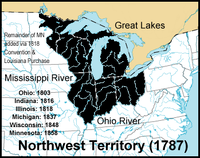Organic act: Difference between revisions
deleting the absurd "stub" notice |
No edit summary |
||
| Line 7: | Line 7: | ||
An '''Organic Act''', in [[United States law]], is an [[Act of Congress|Act]] of the [[United States Congress]] that establishes a [[territory of the United States]] or an [[List of United States federal agencies|agency]] to manage certain federal lands. |
An '''Organic Act''', in [[United States law]], is an [[Act of Congress|Act]] of the [[United States Congress]] that establishes a [[territory of the United States]] or an [[List of United States federal agencies|agency]] to manage certain federal lands. |
||
The first such act was the [[Northwest Ordinance]], passed in 1787 by the U.S. [[Congress of the Confederation]] (under the [[Articles of Confederation]], |
The first such act was the [[Northwest Ordinance]], passed in 1787 by the U.S. [[Congress of the Confederation]] (under the [[Articles of Confederation]], predecessor of the [[United States Constitution]]). The Northwest Ordinance created the [[Northwest Territory]] in the land west of [[Pennsylvania]] and northwest of the [[Ohio River]] and set the pattern of development that was followed for all subsequent territories. The Northwest Territory covered more than 260,000 square miles and included all of the modern states of [[Ohio]], [[Indiana]], [[Illinois]], [[Michigan]], [[Wisconsin]], and the northeastern part of [[Minnesota]]. |
||
The [[District of Columbia Organic Act of 1801]] incorporated [[Washington, D.C.]] and placed it under the exclusive control of the [[United States Congress]]. |
The [[District of Columbia Organic Act of 1801]] incorporated [[Washington, D.C.]] and placed it under the exclusive control of the [[United States Congress]]. |
||
Revision as of 22:40, 10 November 2014



An Organic Act, in United States law, is an Act of the United States Congress that establishes a territory of the United States or an agency to manage certain federal lands.
The first such act was the Northwest Ordinance, passed in 1787 by the U.S. Congress of the Confederation (under the Articles of Confederation, predecessor of the United States Constitution). The Northwest Ordinance created the Northwest Territory in the land west of Pennsylvania and northwest of the Ohio River and set the pattern of development that was followed for all subsequent territories. The Northwest Territory covered more than 260,000 square miles and included all of the modern states of Ohio, Indiana, Illinois, Michigan, Wisconsin, and the northeastern part of Minnesota.
The District of Columbia Organic Act of 1801 incorporated Washington, D.C. and placed it under the exclusive control of the United States Congress.
The Organic Act for the Territory of New Mexico was part of the Compromise of 1850, passed September 9, 1850. Primarily concerned with slavery, the act organized New Mexico as a territory, with boundaries including the areas now embraced in New Mexico, Arizona, and southern Colorado.
List of Organic Acts
Later Organic Acts have included (in chronological order):
Areas now part of a U.S. state or D.C.:
- The Northwest Ordinance
- The Indiana Territory, that had been part of the Northwest, and endured from 1800 until the formation in 1816 of the State of Indiana
- The District of Columbia Organic Act of 1801
- The Organic Act of 1804, with respect to the Territory of Orleans
- The Michigan Territory, partitioned from the Ohio in 1806
- The Illinois Territory, partitioned from the Indiana in 1809
- The Organic Act of 1848, created the Territory of Oregon
- The Utah Territory, created in 1850 after entry to possession dictated by the 1848 Treaty of Guadalupe Hidalgo
- The New Mexico Territory, ibid
- The Kansas Territory, formed in 1854 by the Kansas-Nebraska Act
- The Nebraska Territory, ibid
- The Colorado Organic Act, partitioned the Territory of Colorado in 1861 from the Kansas Territory, as well as some of the southwestern Nebraska Territory, and a small parcel of the northeastern New Mexico Territory.
- The Nevada Territory, partitioned from the Utah Territory in 1861
- The Dakota Organic Act of 1861
- The Arizona Organic Act, created the Territory of Arizona in 1863.
- The Montana Organic Act, created the Territory of Montana in 1864.
- The District of Columbia Organic Act of 1871, created a single municipal government for Washington, D.C.
- The First Organic Act for Alaska of 1884, which allowed for Alaska to become a judicial district as well as a civil one; and the Second Organic Act for Alaska of 1912, which gave Alaska an elected legislature.
- The Oklahoma Organic Act of 1889, established the Oklahoma Territory.
- The Hawaiian Organic Act, enacted in 1900, established a government for the Territory of Hawaii.
Current overseas territories of the United States, known as Insular areas:

- The Foraker Act or Organic Act of 1900, established civilian government in Puerto Rico.
- The Organic Act of the Virgin Islands of the United States of 1936 (Pub. L. 74–749, 49 Stat. 1807, enacted June 22, 1936) established a government for the U.S. Virgin Islands, replacing previous temporary provisions (Pub. L. 64–389, 39 Stat. 1132, enacted March 3, 1917). It was replaced in 1954 .
- The Guam Organic Act of 1950, transferred Guam to the United States Department of the Interior as an unincorporated territory.
- The Revised Organic Act of the Virgin Islands of 1954 repealed and replaced the previous Organic Act of the Virgin Islands.(Pub. L. 83–517, 68 Stat. 497, enacted July 22, 1954)
The Philippines:
- The Philippine Organic Act (1902), creation of an elected Philippine Assembly.
- The Jones Law (Philippines), replaced the 1902 act in 1916 and created a fully elected Philippine Legislature.
Other:
- The National Park Service Organic Act, establishing the National Park Service and the National Park System in 1916.
See also
- Organic law
- The Organic Laws of Oregon of 1843
